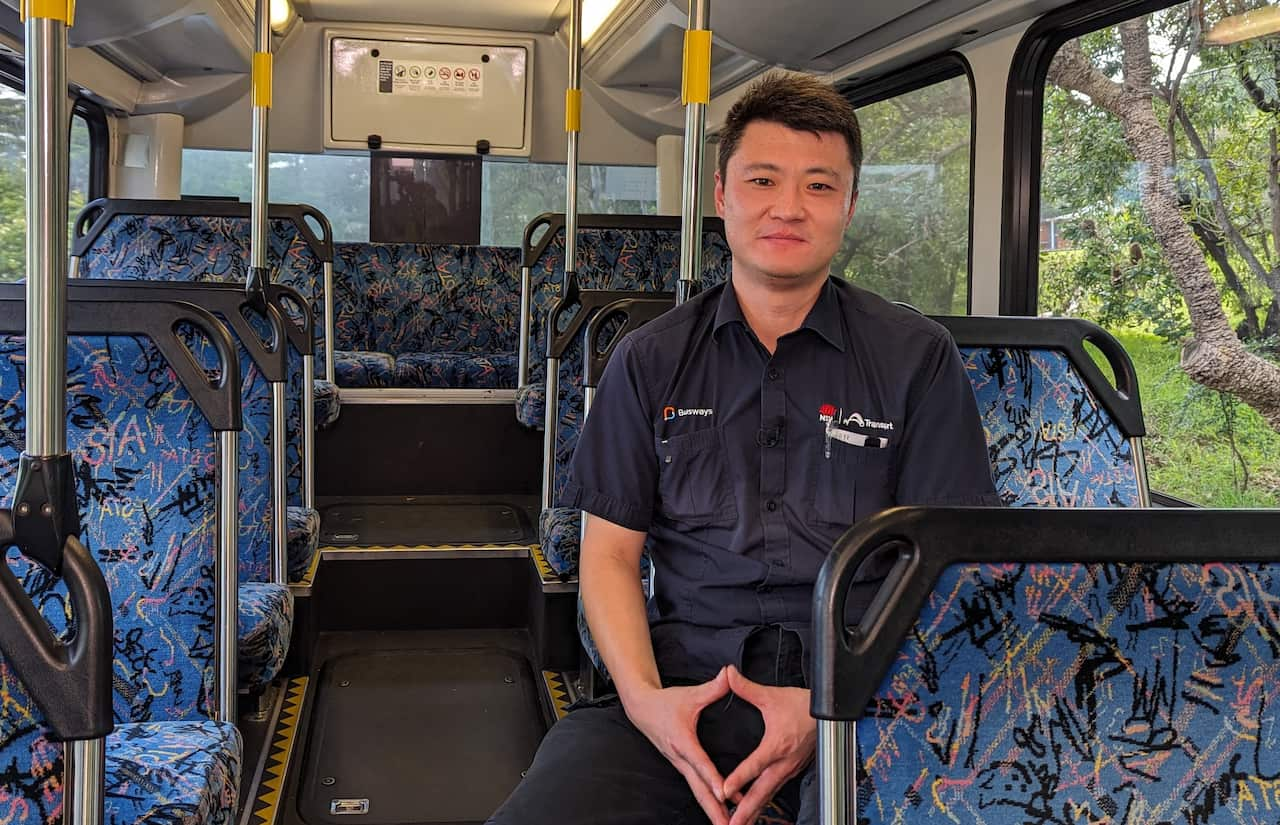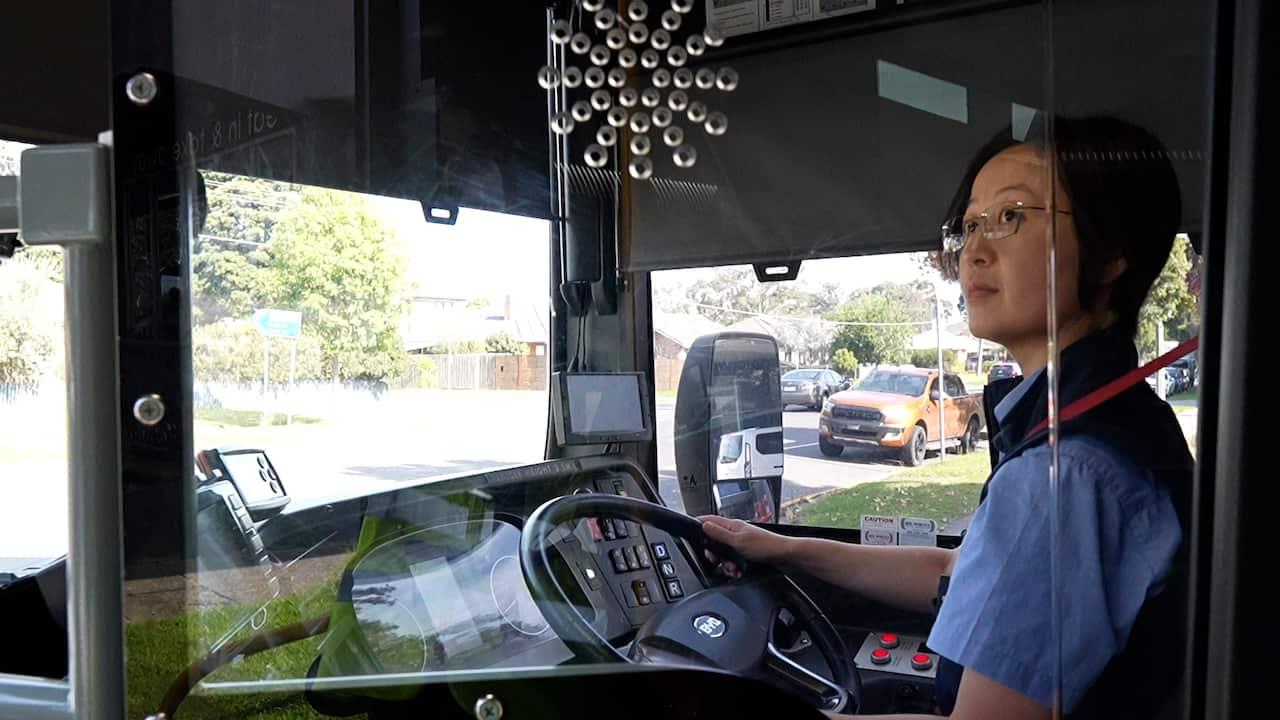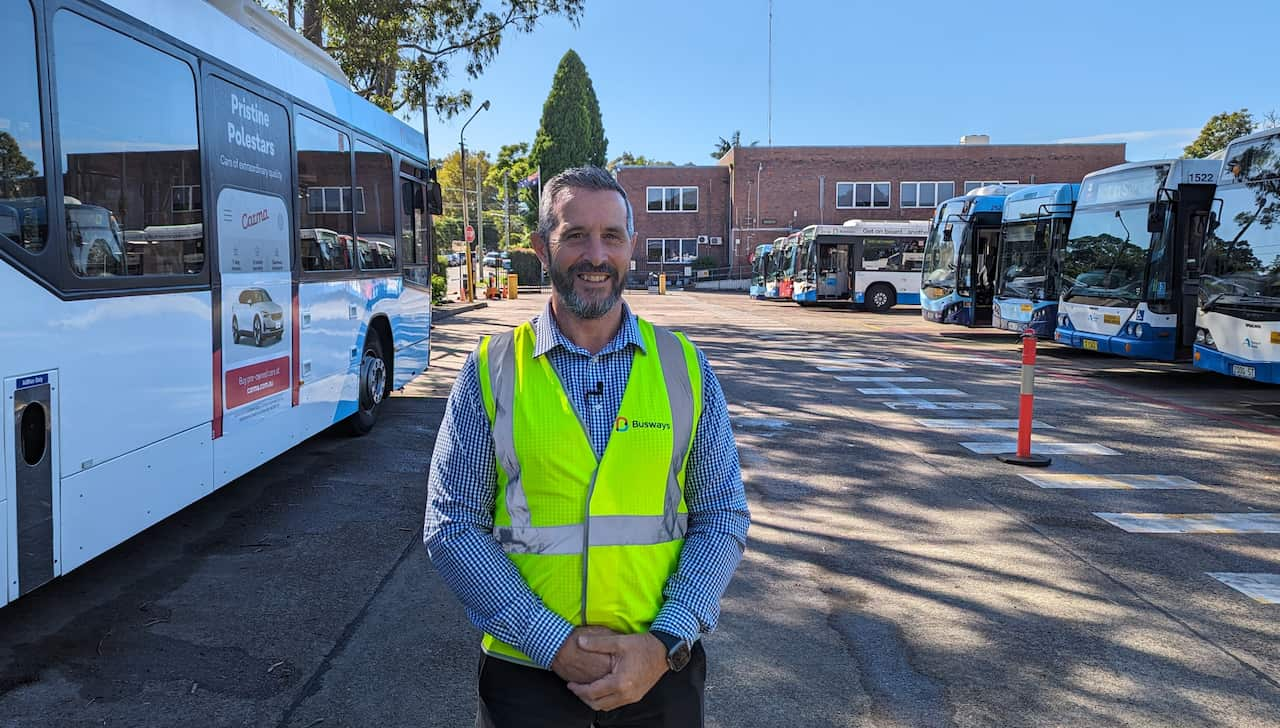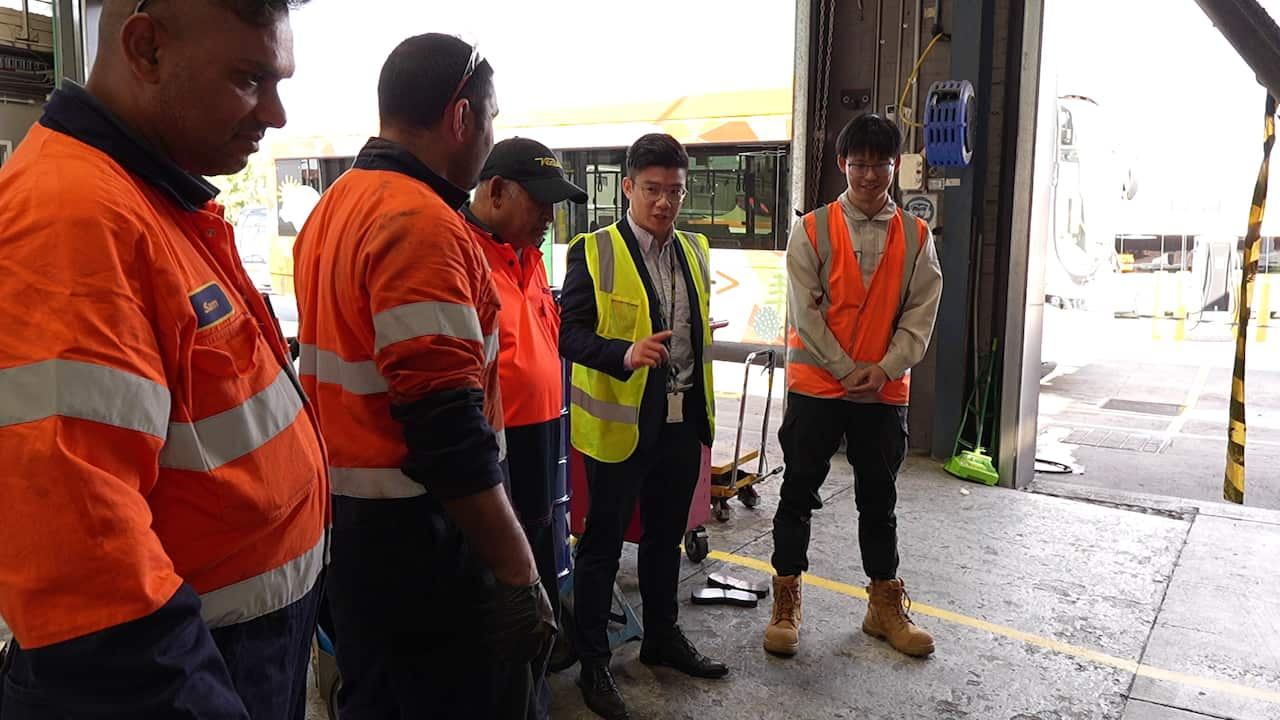Key points
- Bus companies are turning to open days and targeted recruitment plans to attract more bus drivers.
- Rex Song and Lily Zhao swapped office jobs for driving buses.
- Experts say a nationwide shortage of drivers will lead to cancelled services.
Rex Song said unlike his previous office job, his favourite aspect of driving a bus for a living was that he “didn’t have to take work home”.
“All it requires is that you complete the job safely. When I return to the yard, turn off the engine, today is over and tomorrow will be a new day,” Song told SBS Chinese.
However, Song, who has been working for Busways at Sydney’s Willoughby depot since 2019, said bus drivers were often asked to work additional hours due to ongoing staff shortages.
Bus driver Rex Song said he enjoys the flexibility of driving a bus. Credit: SBS Chinese
“For those who want to work more, there are plenty of opportunities for additional shifts,” he said.
Like Song, Melbourne bus driver Lily Zhao said she was often asked to work longer due to staff shortages.
“Sometimes we do overtime work. After finishing a short shift, I might be asked if I can drive a bit more,” she said.
Both said they enjoyed the sense of “freedom” involved with driving a bus in that they were not stuck behind a desk, feeling they could never “switch off”.
The job ‘makes me very happy’
Before becoming a bus driver in Ventura, Lily Zhao worked in administrative finance.
Zhao said being a bus driver was “very cool” and had garnered her the support of her family, as well as respect from the community.
“My family is very proud of me, and I’ve done well since making the complete career switch,” she said.
“One time after a night shift, my husband and son came to the depot to pick me up. When I drove the bus back to the yard, I saw my son clapping for me.
“Every day, I pick up and drop off different people. Sometimes passengers and pedestrians ask questions, and after I answer, they sincerely say ‘thank you’, which makes me very happy.”
Lily Zhao said the job had been “tough” at first. Credit: SBS Chinese
However, the job had been “tough” at first.
“For the first two months, I felt nervous every day, gripping the steering wheel tightly. By the end of the day, my whole body would feel stiff,” she said.
“This job keeps me quite busy, especially with long shifts, making it difficult to tend to family matters.”
Song, who used to work in sales and client services at a dockside machinery company, said “flexibility” had been his main reason for switching careers to bus-driving.
“For example, during the break between the early and late shifts, you can head home and take care of your family,” he said.
“You can completely disconnect from work after hours. (There is) No need to remain confined to the office, tackling similar tasks and interacting with the same people day in and day out.”
For Song, his typical day starts at 5:30am, when he wakes up and heads to the bus depot to sign in. After receiving the daily journal, and checking and confirming the bus’s condition, he then drives the designated route.
He said that the biggest challenge lay in memorising routes and adapting to the specific driving requirements of the bus.
“I have to drive on 20 to 30 different routes every week, and I need to be familiar with every stop – some are hidden behind trees, easily missed – and sometimes I’m asked to cover for other drivers, so I need to know all the routes,” he said.
Ongoing driver shortages
released in February by the NSW Bus Industry Taskforce highlights the ongoing issue of bus driver shortages.
Transport NSW data shows that as of April 2024, there were 356 vacant bus driver positions in Sydney and outer metropolitan areas, slightly down from the peak of 520 vacancies in September last year.
Richard Olsen, secretary for the New South Wales and Queensland branch of the Transport Workers’ Union (TWU), said this number was “similar nationwide”.
Further, latest data from the Bus Industry Confederation (BIC) estimates that from 2017 to 2022, there were 12,000 job openings for bus and coach drivers due to staff turnover.
BIC said in a statement that reasons for the turnover included stresses involved in the job including irregular working hours, pressures on the road and long periods of time sitting idle.
Olsen said that the shortages could lead to bus companies being forced to cancel some services.
“In the week of 8 April (this year), there were over 2,300 bus services cancelled as a result of a bus not being available for whatever reason – it could be maintenance – but by and large, it is because there is no driver available to take the bus out and do a route,” he said.
There is significant pressure on the government and bus companies to recruit additional drivers.
Richard Olsen
“Now there will be a significant jump in the driver shortages (in NSW). The railway between Sydenham and Bankstown will be shut down for 12 months or longer, so we will need buses to commute in that area in Sydney.”
Transport NSW launched a three-month recruitment campaign last year and streamlined the application process for bus drivers, waiving the $70 application fee.
However, the number of applicants for bus driver positions only increased by nine per cent in response.
Lily Zhao said driving a bus had been a “complete career switch”. Credit: SBS Chinese
Domenic Larosa, group service delivery development manager at Busways, said he had noticed an increase in drivers from diverse cultural backgrounds including Indian, Chinese, Italian, Greek and Arabic.
“It really doesn’t matter,” he said. “All you need is a heavy vehicle licence and a basic level of English understanding.”
Zhao said unlike many other professions, language was not a barrier to becoming a bus driver in Australia.
Domenic Larosa, group service delivery development manager at Busways, said bus drivers had various work mode options including full-time, part-time, and casual positions. Credit: SBS Chinese
“You don’t need to worry about it at all. My main job is driving, so there is not much talking involved. At most, I just need to answer passenger questions about where I’m headed and which stop they should get off at,” she said.
Song added that his multicultural background helped with the job.
“Our depot is close to Chatswood, where many Chinese residents live. There are some elderly passengers who don’t speak English. When they ask for directions, I can help them in Chinese,” Song said.
“As a driver mentor, having a similar background can also make it easier to provide training for newcomers.”
‘Plenty of overtime’
Olsen said base salaries ranging from $60,000 to $80,000 per annum were a key factor preventing transportation workers from choosing to become bus drivers.
“They might start as bus drivers, but they won’t stay for long because they know, driving other vehicles can easily earn them an extra $10 per hour,” he said.
Zhao said she was satisfied with her current salary, and bus-driving was a job in which “the rewards are proportional to the effort”.
“The current salary is higher than any of my previous jobs, but it’s hard-earned money. Sometimes, with long shifts, I feel exhausted at the end of the day,” she said.
Larosa said that due to the shift work system implemented, drivers received penalty rates for working outside regular hours.
“The job has plenty of overtime involved in it. There’s additional work in relation to special events. It all comes down to what they want to do, and how much they want to do,” he said.
Jacky Tsang, operation control centre manager at Ventura Bus Oakleigh and Moorabbin, Melbourne, said through active recruitment efforts and covering the costs of obtaining licenses, the current number of drivers in the company was “quite healthy”.
Jacky Tsang (second from the right) said open days were effective ways to attract more people to join the bus-driving industry. Credit: SBS Chinese
“We prioritise open days and run the ‘Women At The Wheel’ program. Now we have over 900 drivers, with approximately 10 per cent being females,” he said.
“We still have around 50 vacant positions. Over the past 12 months, the vacancies had reached about 100 at one point.
“We try to accommodate drivers’ preferences. For instance, if they only want to work the morning shift, we arrange that for them; if they only want to work for four hours a day, we have casual positions.”




